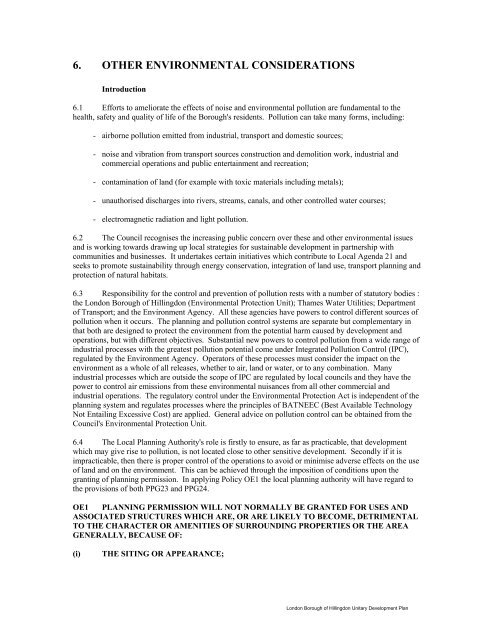HILLINGDON UNITARY DEVELOPMENT PLAN - London Borough ...
HILLINGDON UNITARY DEVELOPMENT PLAN - London Borough ...
HILLINGDON UNITARY DEVELOPMENT PLAN - London Borough ...
You also want an ePaper? Increase the reach of your titles
YUMPU automatically turns print PDFs into web optimized ePapers that Google loves.
6. OTHER ENVIRONMENTAL CONSIDERATIONS<br />
Introduction<br />
6.1 Efforts to ameliorate the effects of noise and environmental pollution are fundamental to the<br />
health, safety and quality of life of the <strong>Borough</strong>'s residents. Pollution can take many forms, including:<br />
- airborne pollution emitted from industrial, transport and domestic sources;<br />
- noise and vibration from transport sources construction and demolition work, industrial and<br />
commercial operations and public entertainment and recreation;<br />
- contamination of land (for example with toxic materials including metals);<br />
- unauthorised discharges into rivers, streams, canals, and other controlled water courses;<br />
- electromagnetic radiation and light pollution.<br />
6.2 The Council recognises the increasing public concern over these and other environmental issues<br />
and is working towards drawing up local strategies for sustainable development in partnership with<br />
communities and businesses. It undertakes certain initiatives which contribute to Local Agenda 21 and<br />
seeks to promote sustainability through energy conservation, integration of land use, transport planning and<br />
protection of natural habitats.<br />
6.3 Responsibility for the control and prevention of pollution rests with a number of statutory bodies :<br />
the <strong>London</strong> <strong>Borough</strong> of Hillingdon (Environmental Protection Unit); Thames Water Utilities; Department<br />
of Transport; and the Environment Agency. All these agencies have powers to control different sources of<br />
pollution when it occurs. The planning and pollution control systems are separate but complementary in<br />
that both are designed to protect the environment from the potential harm caused by development and<br />
operations, but with different objectives. Substantial new powers to control pollution from a wide range of<br />
industrial processes with the greatest pollution potential come under Integrated Pollution Control (IPC),<br />
regulated by the Environment Agency. Operators of these processes must consider the impact on the<br />
environment as a whole of all releases, whether to air, land or water, or to any combination. Many<br />
industrial processes which are outside the scope of IPC are regulated by local councils and they have the<br />
power to control air emissions from these environmental nuisances from all other commercial and<br />
industrial operations. The regulatory control under the Environmental Protection Act is independent of the<br />
planning system and regulates processes where the principles of BATNEEC (Best Available Technology<br />
Not Entailing Excessive Cost) are applied. General advice on pollution control can be obtained from the<br />
Council's Environmental Protection Unit.<br />
6.4 The Local Planning Authority's role is firstly to ensure, as far as practicable, that development<br />
which may give rise to pollution, is not located close to other sensitive development. Secondly if it is<br />
impracticable, then there is proper control of the operations to avoid or minimise adverse effects on the use<br />
of land and on the environment. This can be achieved through the imposition of conditions upon the<br />
granting of planning permission. In applying Policy OE1 the local planning authority will have regard to<br />
the provisions of both PPG23 and PPG24.<br />
OE1 <strong>PLAN</strong>NING PERMISSION WILL NOT NORMALLY BE GRANTED FOR USES AND<br />
ASSOCIATED STRUCTURES WHICH ARE, OR ARE LIKELY TO BECOME, DETRIMENTAL<br />
TO THE CHARACTER OR AMENITIES OF SURROUNDING PROPERTIES OR THE AREA<br />
GENERALLY, BECAUSE OF:<br />
(i)<br />
THE SITING OR APPEARANCE;<br />
<strong>London</strong> <strong>Borough</strong> of Hillingdon Unitary Development Plan
















